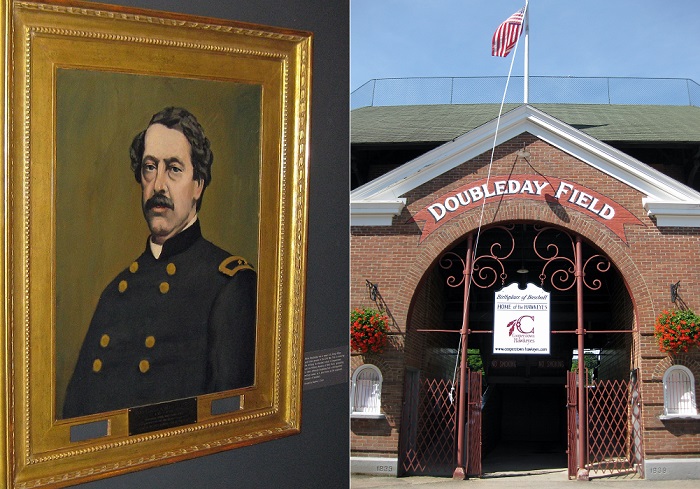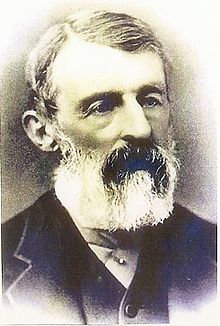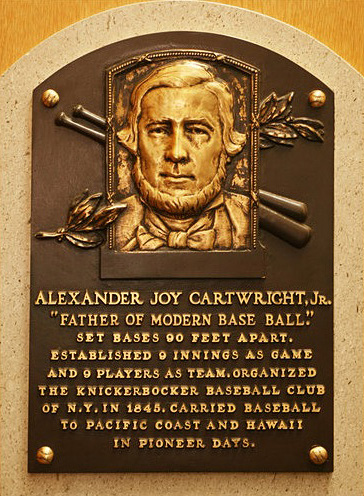As a youngster growing up surrounded by the wonderful world of baseball, I was led to believe that Abner Doubleday was the inventor of the game, having patterned it after a game called “rounders,” which originated in England. Records suggest that the English game may have been played 100 years before baseball was born in the United States. Doubleday was a career United States Army officer and Union general during the Civil War.
I had no reason to doubt the validity of the claim and it seems many connected close to the game – especially baseball historians – also fell into the same trap. That is, until further creditable research dispelled the myth that Abner Doubleday was the inventor of baseball.
Major General Doubleday, to his credit, had never made such a claim and in his volumes of letters and papers left behind after his death, there was no reference that would suggest he was even remotely connected to the evolution of the game.

Although Abner Doubleday is in the museum portion of the National Baseball Hall of Fame and Museum and the legendary baseball field in Cooperstown, New York is named after him, he is not The Father of Baseball.
(Photo credit – Ron Cervenka)
While myths are quite often inventions – intentional or unintentional – offering unsubstantiated explanations for events or circumstances, Abner Doubleday in no way ever contributed to the myth that he was the inventor of baseball. As things stand now, Al Spalding gets the credit (or discredit) for bringing forth the claim that Doubleday formulated the rules and regulations for baseball in 1839.
Spalding brought forth a panel’s findings that Doubleday had invented baseball in his home town of Cooperstown, New York; that would be the same Al Spalding of sporting goods fame and himself a member of the Hall of Fame. With no written documents, no creditable collaborative witnesses, coupled with the fact that Abner Doubleday was at West Point in 1839 with no record of leave time, Spalding’s assertions that the war hero was in Cooperstown in 1839 were soon questioned and in due course debunked.
With Abner Doubleday discounted as “The Father of Baseball,” that claim to fame was given to Alexander Cartwright when he became a member of the Hall of Fame in its third induction class in 1938. He assuredly was an important figure in the early development of the game. He worked hard to raise the profile of the game with the American people, as well as to give it a structure that would be followed no matter where it was played.
Cartwright perhaps provided baseball’s Magna Carta when his Knickerbocker Rules were published on September 23, 1845. His treatise included 20 rules under which the game would be played in an attempt to standardize the game and make it recognizable by all who played or watched it being played. Many of his rules have persisted to this day, such as three outs, using an umpire to adjudicate disputes, batting in turn, foul balls and even a balk giving the runner the next base freely.
The first game played under the Knickerbocker Rules was on June 19, 1846 at Elysian Fields in Hoboken, New Jersey. It was the first known documented game and one in which Cartwright’s Knickerbockers lost to the New York Nine by a score of 23 to 1.
There can be no doubt that Alexander Cartwright was a father of major league baseball but perhaps not the father. He was elected to the Hall of Fame in 1938 by the Veteran’s Committee. This is in no way to question Cartwright’s Hall of Fame worthiness or status, but somehow they erred in crediting him with certain crucial elements of the game.
On his Hall of Fame plaque Alexander Cartwright is declared to be the “Father of Modern Baseball” and the plaque lists three rules of the game which are attributed to him:
- “Set Bases 90 Feet Apart,”
- “Established 9 Innings as Game,”
- “9 Players as Team.”
In actuality, the Knickerbocker Rules are stated in following manner:
- “The bases shall be from home to second base, forty-two paces; from first to third base, forty-two paces, equidistant”
- “The game to consist of twenty-one counts, or aces; but at the conclusion an equal number of hands must be played”
- “If there should not be a sufficient number of members of the Club present at the time agreed upon to commence exercise, gentlemen not members may be chosen in to make up the match, which shall not be broken up to take in members that may afterwards appear; but in all cases, members shall have the preference, when present, at the making of a match.”
Why the Hall of Fame would have credited the rules listed on his Hall of Fame plaque to Cartwright remains another mystery regarding the birth of baseball. It seems there was a perceived need to pinpoint the exact moment that “America’s Pastime” was born.
To further cloud the issue as to who the actual “Father of Modern Baseball” really is, President Theodore Roosevelt credited that title to Henry Chadwick in his birthday wishes to the Exeter, England native in 1904.
Chadwick was a journalist (not a player) who had a passion for the game and a strong desire to promote it far and wide. He was a prolific writer who penned what was thought to be the first baseball guide in 1860 and took on the role of editor for Spalding’s Official Base Ball Guide.
Chadwick was the father of the baseball box score, which was designed to bring the game to the fans in his newspaper columns. He was also a statistician documenting statistics such as runs, hits, put-outs, assists and errors, as well as batting average and earned run average. Interestingly enough, he recorded the pitchers’ strikeouts, denoting them with the letter ‘K.’
“The box score was the only way of showing the game, there really was no photography,” said Chadwick biographer Andrew Schiff. “So, the writer really was the person at the center between the fans and the player at the game.”
Chadwick became a member of the Hall of Fame in 1938, the same year as Alexander Cartwright’s induction into the national institution.
Henry Chadwick is acknowledged on his Hall of Fame plaque as the authoring baseball’s first rule book in 1858 and is the only journalist to be inducted into the actual Hall itself – as opposed to being recognized with a Ford C. Frick award, as are other journalists and broadcasters. He is surely a deserving member, especially in light of his comments regarding the beauty of the game.
“Americans do not care to dawdle over a sleep-inspiring game all through the heat of a June or July day,” wrote Chadwick. “What they do they want to do in a hurry. In baseball, all is lightning; every action is as swift as a seabird’s flight.”
It was thought that the “Father of Baseball” issue had been settled once and for all until there was a new development in 2016. If the “Knickerbocker Rules” were the Magna Carta of baseball, then the discovery of the Adams papers would be akin to finding the Dead Sea Scrolls for those of us who have baseball as a spiritual second religion.
The Adams papers surfaced in 1999 when an unnamed individual bought them at a historical document auction for $12,000. Not knowing what he had stumbled upon, he kept them in a desk drawer until about a year ago. Perhaps out of curiosity he then took them to SCP Auctions to see what they really were and if they were authentic. Their significance slowly emerged after considerable forensic, handwriting and historical analysis.
“It just got better and better and more and more compelling,” said Dan Imler, vice president of SCP Auctions. “It was just mind-blowing once we fully realized what we had.”
The unnamed gentleman had unknowingly acquired documents dating back to 1857 titled “Laws of Base Ball,” which establish the essentials of the modern game. The author was Daniel Lucius “Doc” Adams, not Alexander Cartwright. Those documents which the unnamed gentleman had purchased for $12,000 in 1999 were sold by SCP on Sunday, April 24, 2016 for $3,260,000, setting a new record for the highest-priced document in baseball history.

Daniel ‘Doc’ Adams
(Wikipedia photo)
Adams, who was an actual doctor, was a member of the Knickerbocker baseball club that played in that first documented game umpired by Alexander Cartwright on June 19,1846.
Among other contributions to the game, Adams created the shortstop position and actually became the first shortstop in baseball history. He did so to cut down on the long throw from the outfield to home plate on the left side of the diamond. He is also responsible for:
- Defining some of the distances and numbers that still prevail in the game today,
- Established the distance between bases at 90 feet with each base being one square foot,
- Set the length of games at 9 innings,
- Supported nine-man baseball teams,
- Advocated the fly-game which no longer permitted an out to be made on a first-bound catch.
The original rules written by Daniel Lucius “Doc” Adams stipulated that the ball can’t weigh less than five and three-quarter ounces and that although a bat could be of any length, it could not be more than two and one-half inches at its widest part.
The Adams’ family – no pun intended – has made a concerted effort to have him acknowledged in the Hall of Fame. He was on the ballot in 2016 but baseball’s Pre-Integration Era Committee gave him only 10 of 16 votes. It is perhaps unbelievable that he did not receive the necessary 12 votes to be elected into the Hall of Fame.
That being said, it is impossible to believe that Doc Adams will not soon take his rightful place in the National Baseball Hall of Fame and Museum, along with Alexander Cartwright and Henry Chadwick; all of whom breathed life into the game that we so love and enjoy.




 January 15th, 2017 at 7:00 am
January 15th, 2017 at 7:00 am  by Harold Uhlman
by Harold Uhlman 
 Posted in
Posted in 

Outstanding article, Harold!
#WhoKnew
Ditto – fantastic read!!
One of the best articles on baseball history, I’ve ever read. Thanks Harold.
Fantastic article Harold, really informative. I knew about the stories surrounding Abner Doubleday, Henry Chadwick, and Alexander Cartwright but never heard of Daniel “Doc” Adams. I always read that Al Spalding wanted baseball to be a truly American game and have no connection to the English. That’s why, as you said, he pushed the myth of Doubleday inventing the game.
[…] Uhlman recently wrote a very interesting article on Think Blue LA titled “MLB has more than one Daddy” that explores the origin of baseball. It illustrates the misinformation of the past creation […]